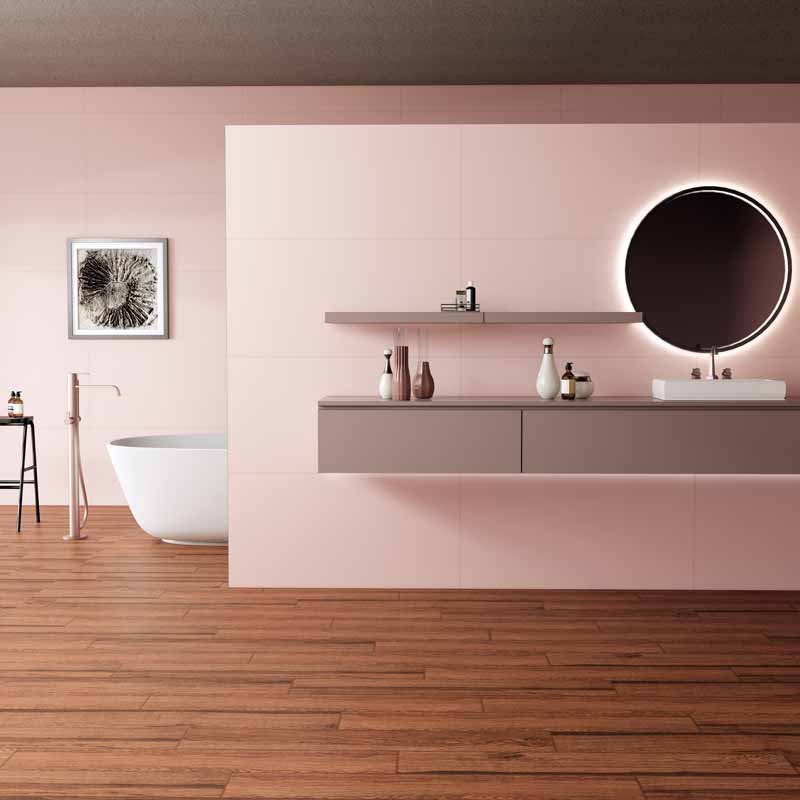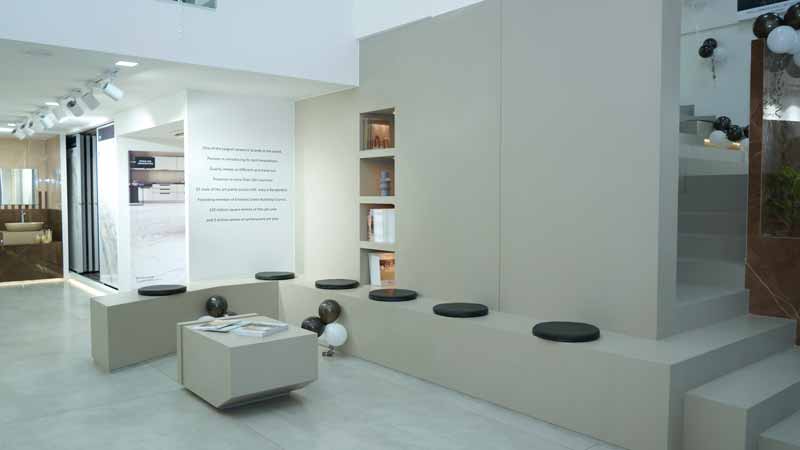
Tiles market in India- An overview
India’s ceramic tile market is one of the fastest growing markets in the world owing to factors like rising demand, housing shortage, developing real estate, rising disposable income, expansion of metro cities, government policies etc. According to a market research firm, the Indian Tiles, Sanitary Ware and Bathroom Fittings Market: Industry Trends, Share, Size, Growth, Opportunity and Forecast 2021-2026, the Indian tiles, sanitary ware and bathroom fittings market reached a value of US$ 7953 Million in 2020. Looking forward, the report expects the Indian tiles, sanitary ware and bathroom fittings market to grow at a CAGR of 9.30% during 2021-2026. The global ceramic tiles market was pegged at US$ 97 billion in 2019 and was expected to expand at a CAGR of 9% between 2019 and 2029 to reach US$ 228 billion by 2029. A large share of the world production came from the Asia Pacific region with China being the biggest manufacturer of ceramic tiles in the world followed by India. Further, in terms of volume (million sqft.) the market is expected to expand at a CAGR of 7.6% between 2019 and 2027.

India is not only the second-largest producer of ceramic tiles in the world after China but also the second-largest consumer of ceramic tiles in the world after China with a consumption quantum pegged at 750 million square metres and accounting for almost 6% of the world. India is also the fourth-largest exporter of ceramic tiles with the export quantum pegged at 274 million square metres compared to 228 million square metres in 2017, accounting for a global share of 10%. According a a report by Capital Mind, in the organized tiles space, Kajaria is the market leader, with 11% share of the overall market and 25% of the organized market. Somany and Prism Johnson have 6% each of the overall market and 15% each of the organized pie. Other players in the organized market are – AGL, Orient Bell, Nitco, RAK, Simpolo, Varmora, Qutone, Sunheart and some more
Anil Beejawat CEO, RAK India

What kind of product development is currently happening in your brand?
Leveraging outdoor spaces to create areas for socialising and collaborating provides greater choice for safer work environments nowadays, RAK Ceramics has launched Aaron Collection, 15 mm thick GVT tiles for outdoor and are most relevant in today’s scenario. RAK-Sanit collection offers an even wider range of solutions for floors, walls and sanitaryware, made with glazes that inhibit the growth of bacteria, thus reducing the possibility of contagion and contributing to create a healthier environment. Also, use of RAK cool roof tiles under KLIMA sub-brand, we can have ambiente temperature inside the workspaces thereby reducing the need of air conditioners. RAK India has launched its step n riser product range to cater to customers looking at preferable staircases and is available in 9 colours and design. Customers must feel Confident to step on the RAK Step & Riser Confi collection (Confi from Confident).
Manufacturing operations are hindered by the volatility in the price of natural gas, which accounts for between 15% and 30% of production costs and ever-higher transportation costs.
Kajaria Vitronite slabs are the latest offering by Kajaria. It has two positioning statements, one as new age kitchen tops for modern kitchen and second, as new age granite & Italian marble.

Factors affecting the growth of industry
One of the unique qualities of Indian ceramic tile industry is that nearly 40% of the industry is organised, while 60% was largely unorganised comprising players from Morbi, Rajkot and other clusters. The ratio seems to be slowly reversing. And everyone seem to be generating good profits. As India is a big market, it is fact that there is growth for everyone be it organized or unorganized players. Here are few factors that are driving the high growth rate of the industry in India.

Rapid Urbanization
Expansion of metro cities and migration of people from villages to cities is a major growth driver for the growth of tiles market in India. There are investments being made in housing, urban transport, power-related infrastructures, smart cities, and other forms of urban expansion that will lead to rise in new cities and ultimately the requirement of raw materials.
Government Policies
Schemes like Make in India, Sanitations schemes and Housing for All are already showing their positive impact on the sector with a mjor boost in the demand. The government’s push to housing and sanitation development along with favourable market conditions and initiatives for make in India goods are positively impacting the business of major tiles brands including Kajaria, Somany, AGL etc. Also according to the Indian Tiles industry Report 2021, government schemes - like Pradhan Mantri Awas Yojana (Urban and Gramin) that aim at ‘housing for all’ by the year 2022, with an estimate of providing around 2 crore houses to eligible recipients, out of which 104 lakh houses are already sanctioned till date, will certainly drive the demand for tiles in India for next few years. According to Anil Beejawat, CEO, RAK India, “India is one of the fastestgrowing ceramic tile marketplaces at the global level. Some of the major factors augmenting the growth of the ceramic tiles demand in India are the growing real estate sector coupled with government policies fuelling strong growth in the housing sector. In addition, rising disposable income in India and a corresponding desire for beautification of living and working spaces are also driving the need for ceramic tiles in the country. Demand for products like the new touchless and other hygiene-centric products in bath ware and the germ-free tiles will take centre stage and will see traction in coming period.
Due to a shortage of labour, the timely completion of projects has become one of the major challenges for ceramic tile manufacturers amid the pandemic. However, once the lockdown started to reverse back, the tile industry was first to emerge out of the crisis stronger than ever, and the recovery in demand in the ceramic tile industry in India is expected to thrive exponentially. Now, manufacturing operations are hindered by the volatility in the price of natural gas, which accounts for between 15% and 30% of production costs and ever-higher transportation costs. The pandemic has also raised the demand for hygienic and easy-to-clean flooring products.”
Constant need for infrastructure
Not only residential, India’s hospitality and retail segment too is expecting higher growth in near future giving a huge traction to the tiles industry. While both industries suffered a major setback during the pandemic, they seem to be recovering as the world moves towards normalization. The hotel industry in India is projected to grow to Rs. 1,210.9 billion by 2023, on the back of high arrival rate of foreign tourists and business delegates once the world normalises. Also, India is set to add around 65 million sqft of new mall spaces by the end of 2022 and according to a Knight Frank India report, the country’s office leasing volume rose by 27% in 2019, on the back of a surge in leasing activity by information technology companies and this growth is not expected to slow down anytime soon.
New Products and Initiatives
With the relaxations of COVID restrictions and booming real estate activities, tiles brands have too geared up with the new launches and taking measures for higher market penetrations. As the charm of touch and feel comes back, there are new showrooms being opened up not in the metro but in tier 2 and 3 cities as well in order to get maximum consumer footfall and better leverage opportunities. In addition, brands are also revamping their exisiting showrooms following the covid protocols and in better lieu of the changing customer needs. For instance, customers in west zone can explore new collections at RAK’s recently revamped flagship showrooms at Vega Centre, Pune and Santacruz(w), Mumbai.
Subrata Basu, VP- Marketing, Nitco says, “At NITCO, we have already taken measures to strengthen and reinforce our dealer network in stronger markets, with focus is on improving inhouse share through several support activities such as loyalty programs, annual tie ups etc. For the markets with lower penetration the white spaces have been clearly identified and the partner scouting, evaluation and appointment will be done swiftly to ensure appropriate presence across all markets.
In terms of sizes and design, bigger format tiles are showing an impact on the market as most brands are coming up with sizes bigger than ever. Not only for the internal purposes, these tiles can now be used for exterior and higher traffic areas thanks to the higher thickness the brands are offering. Lesser grout lines, fast installation and higher aesthatics are some of the factors leading to the development of these tiles. RAK Ceramics has large format tiles under Maximus sub-brand in 1200 x 2400 mm, 1200 x 1800mm, 900 x 1800 mm, 800 x1600 mm, 1200 x 1200 mm sizes in natural stone, concrete, marble, textiles and wood like designs in various finishes and colours giving a bright, clean and sophisticated looks to the walls and floors.
Another major shift in the market that has come as a result of COVID-19 is the focus on hygienic products and development of surfaces that inhibits microbial growth. More brands are coming up with such products to cater to the new consumer segment who is health conscious and want a safe haven for his family. For instance, Asian Granito Indi Ltd has launched ‘AGL Tuffguard Anti-Bacterial Tiles’ for better hygiene. These tiles are 99% effective against the growth of bacterial and germs due to its tuff guard plus anti-bacterial glazing made of Silver Ions.
Subrata Basu VP-Design, Nitco

What kind of further innovation can we expect in the coming few months?
We are always innovating when it comes to tile sizes and designs. Our Made In Italy collection of tiles has sizes like 8x4 ft that are the only tiles in India to withstand heavy duty traffic and especially suited for malls, airports, etc. Our Gibraltor collection features tiles in sizes of 600x1200 mm, while our new Wall Tiles collection comes in sizes of 300x600 mm. The designs are a result of various inspirations around. Like, our Enso Décor tile is inspired by Enso is a sacred symbol in Zen Buddhism meaning circle, or sometimes, circle of togetherness. It is traditionally drawn using only one brushstroke as a meditative practice in letting go of the mind and allowing the body to create, as the singular brushstroke allows for no modifications.
.We also undertook several initiatives like pre-polished and cut to size marble for sites, factory finish window sills, door jambs, steps, and risers, etc to reduce wastage, improve efficiency and improve quality with a quick turnaround time. With labor shortages at almost all sites, our innovations helped projects go on and stick to their initial timelines. It is a very unique and modern approach towards value addition in this segment.
With the festive season in full swing and consumer sentiment at a record high, housing sales are likely to grow. Thanks to record low interest rates, stable housing prices, stable employment scenario and growing homeownership sentiment, residential sales and new launches have surged in recent months. This can be a positive boost for the tiles market.
Key Challenges for the market
With every growth, comes major challenges and tiles market is no exception. The market is currently facing major challenges that may prove to be a deterrent in its growth drive. One of the biggest challenge is the higher cost of raw materials. With rising cost of raw materials, the rates are constantly going up, leading the customers to look for cheaper options. Also, since there is a large competition among the organized and unorganized players in the tile segment, the manufacturers are bound to keep the rates lower as the customer is spoilt for choice as he can easily get the quality and prices in other brackets.
Dinesh Vyas, Advisor, H&R Johnson says, “Indian tile Industry has performed quite strongly in spite of some constraints which many other industries too faced. Input cost is a big concern. As the Industry works in much lower margins unlike many others, passing it on to the customer becomes a compulsion. An increase of Rs. 5 to 15 per square foot in tile’s price is still a very small portion of the total cost of interiors. Other relevant point is that today good tiles are available at various price points and basic ones still work out more economical and technically superior than non-tile options in the long term.”
Echoing the sentiment Subrata Basu, VP-Design Nitco says, “Rising costs and unexpected deviations in raw material price levels destabilize the supply chains and render it difficult for manufacturers to sustain in the competitive ceramic tiles market.
The largest importer of Indian tiles is the GCC region, 40% of Indian exports are to this region. Recently there has been anti dumping duty on exports from India. GCC the largest importer had announced a provisional duty of 40% to 106% on Indian tiles. These duties will impact Indian players.
Another major concern that manufacturers spoke during their conversation with SURFACES REPORTER (SR) is that there is lack of good quality masons as the brands seem to be investing only in product but not in its laying which is a crucial factor for the success of the product since no matter how good a product is, if it is not laid properly, it is bound to fail.
.Pointing towards the major fall, Dinesh Vyas, Advisor, H&R Johnson says, “The real shortfall that Industry should be worried about is - tile laying and not tile making! Availability of trained masons, contractors as well as using right tools and adhesives is a grave concern. Indirectly it is hurting the industry. No single player seem to be ready to take the lead and I think industry as whole should come forward and do something good with all seriousness, not just one dozen masons meeting and distributing gifts there. I am sure adhesive companies too will join the initiative if and when it happens.
Hence, the brands need to come up for the proper training of masons and creating a major workforce that will not only aid in generating the employment but will also provide the masons a way to improve their work quality. In this regard, there is one Somany Tile Master Training Program, where Ameya Somany is taking initiative to train the masons and helping them achieve better employment opportunities by training them and providing them with the right tools.
Dinesh Vyas Advisor, H&R Johnson

Tell us about HRJ’s future plans?
Aesthetics is a subjective decision and to cater wide spectrum of customers, the range becomes big in terms of sizes, colours, textures and themes. HRJ’s product strategy has been to add value to these basic differentiators) by bringing in its some unique benefit. Johnson has many such innovative laments including few patented features for example – its Germ Free range of products or Anti-static tiles for server room applications. HRJ recently announced production readiness of another breakthrough product – Radiation Shielding Tiles as alternative to presently used sheets of lead. The product is based on CSIR- Advanced Materials and Processes Research Institute research, Bhopal.